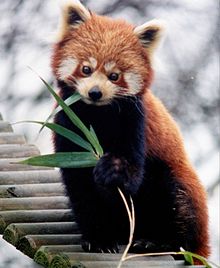Ailuridae
| Ailuridae Temporal range: Oligocene–Recent |
|
|---|---|
 |
|
| Red panda | |
| Scientific classification | |
| Kingdom: | Animalia |
| Phylum: | Chordata |
| Class: | Mammalia |
| Order: | Carnivora |
| Suborder: | Caniformia |
| Infraorder: | Arctoidea |
| Superfamily: | Musteloidea |
| Family: |
Ailuridae Gray, 1843 |
| Genera | |
|
Amphictis (†) |
|
 |
|
| Extant red panda distribution. | |
Amphictis (†)
Alopecocyon (†)
Protursus (†)
Simocyon (†)
Magerictis (†)
Pristinailurus (†)
Parailurus (†)
Ailurus
Ailuridae is a family in the mammal order Carnivora. The family consists of the red panda (the sole living representative) and its extinct relatives.
Frédéric Georges Cuvier first described Ailurus as belonging to the raccoon family in 1825; this classification has been controversial ever since. It was classified in the raccoon family because of morphological similarities of the head, colored ringed tail, and other morphological and ecological characteristics. Somewhat later, it was assigned to the bear family.
Molecular phylogenetic studies show that, as an ancient species in the order Carnivora, the red panda is relatively close to the American raccoon and may be either a monotypic family or a subfamily within the procyonid family. An in-depth population analysis study stated: “According to the fossil record, the Red Panda diverged from its common ancestor with bears about 40 million years ago (Mayr 1986). With this divergence, by comparing the sequence difference between the red panda and the raccoon, the observed mutation rate for the red panda was calculated to be on the order of 109, which is apparently an underestimate compared with the average rate in mammals. This underestimation is probably due to multiple recurrent mutations as the divergence between the red panda and the raccoon is extremely deep.”
...
Wikipedia
